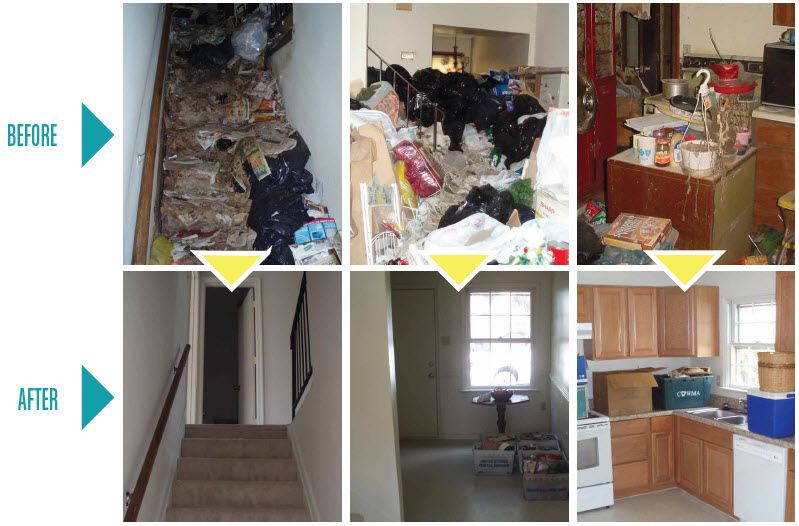Hoarding, a complex psychological disorder characterized by the persistent difficulty in parting with possessions, has far-reaching consequences that extend beyond cluttered living spaces. Individuals grappling with hoarding face profound emotional and mental challenges, often leading to a diminished quality of life. In this blog, Olympia’s Biohazard & Restoration LLC, will help you enter the intricate web of the psychological impact of hoarding, shedding light on the underlying issues that contribute to this disorder. Additionally, we explore the crucial role of compassionate cleanup services in addressing both the visible symptoms and the underlying psychological factors associated with hoarding.
Understanding Hoarding as a Psychological Disorder:
Hoarding is a complex psychological disorder that goes beyond a mere aversion to decluttering or a preference for a more eclectic living space. Classified as a distinct mental health condition, hoarding disorder is characterized by persistent difficulties in parting with possessions, leading to the accumulation of excessive and often unnecessary items. This disorder is not solely about untidiness; rather, it involves intricate cognitive, emotional, and behavioral patterns that significantly impact an individual’s daily life.
Cognitive Aspects:
Cognitively, hoarding is marked by distorted beliefs about possessions and decision-making. Individuals with hoarding disorder often attach sentimental or intrinsic value to items that others might perceive as worthless. This distorted cognitive process contributes to the persistent accumulation of possessions, as the act of discarding becomes emotionally distressing. Common thoughts include fears of needing discarded items in the future, concerns about wastefulness, or a sentimental attachment that elevates the perceived value of even mundane objects.
The cognitive challenges associated with hoarding can create a mental barrier, making it difficult for individuals to conceptualize the necessity of decluttering or the potential benefits of a less cluttered living space. This cognitive aspect is central to understanding why hoarding is not a simple matter of organization but rather a manifestation of deeply rooted thought patterns.
Emotional Facets:
Emotionally, hoarding is closely tied to anxiety, depression, and shame. Anxiety arises from the fear of making the wrong decision about what to keep or discard, leading to an overwhelming sense of responsibility for possessions. Reading about how emotional toll takes place in hoarding cleanups in Portland, will help you gain more knowledge in this regard. Depression often stems from the isolation and deteriorating living conditions that hoarding can cause, amplifying the individual’s sense of hopelessness and despair.


Shame plays a particularly significant role in hoarding disorder. Individuals often feel profound embarrassment about their living conditions, leading them to withdraw from social interactions. This isolation exacerbates the emotional challenges associated with hoarding, creating a feedback loop where the cluttered environment reinforces the negative emotions that triggered the hoarding behavior in the first place.
Behavioral Components:
Behaviorally, hoarding is characterized by specific patterns such as excessive acquisition of items, difficulty discarding possessions, and an intense need to save even seemingly inconsequential items. The behavioral manifestations of hoarding contribute to the visible clutter that accumulates in living spaces, further impacting an individual’s day-to-day functioning.
The act of acquiring items is often driven by a perceived need, sentimental attachment, or the irresistible urge to collect. Discarding possessions becomes an agonizing task, triggering distress and discomfort. The compulsion to save items, even those with little practical value, becomes a coping mechanism that temporarily alleviates the emotional distress associated with parting with possessions.
Understanding hoarding as a psychological disorder requires recognizing these intertwined cognitive, emotional, and behavioral components. Each element plays a role in sustaining the disorder, creating a complex and challenging condition that requires a multifaceted approach for effective intervention and treatment.
The Profound Psychological Impact:
Living amidst clutter and filth has profound implications for an individual’s mental well-being. Hoarding often isolates individuals from social connections, exacerbating feelings of shame and embarrassment. The shame associated with the condition can be so overwhelming that individuals withdraw from friends and family, further intensifying their sense of isolation.
The constant battle to maintain living spaces amidst the clutter can lead to chronic stress and anxiety. Hoarding individuals are often haunted by the fear of judgment, eviction, or legal consequences, adding another layer of psychological burden. Moreover, the cluttered living conditions contribute to a cycle of negative reinforcement, as the individual’s environment reinforces the emotional distress that triggered the hoarding behavior in the first place.
The psychological impact extends beyond the individual suffering from hoarding; it affects family members and friends who may be helpless witnesses to the gradual decline in their loved one’s quality of life. The strain on relationships can be immense, as the hoarding behavior becomes a source of tension, frustration, and concern for those in the individual’s immediate circle.
Addressing Hoarding: A Multifaceted Approach:
Understanding hoarding as a psychological disorder is pivotal in developing effective strategies for intervention and support. While the primary focus is often on cleaning up the physical clutter, a comprehensive approach involves addressing the underlying psychological factors that contribute to hoarding behavior.
Therapeutic interventions, such as cognitive-behavioral therapy (CBT), have shown promise in treating hoarding disorder. CBT helps individuals identify and challenge maladaptive thought patterns and develop healthier coping mechanisms. Additionally, support groups and counseling play a crucial role in breaking the isolation that often accompanies hoarding.
However, the hoarding cleanup process itself is a critical component of the intervention. The accumulated clutter poses not only physical health risks but also serves as a tangible representation of the emotional turmoil experienced by the hoarder. Recognizing the need for specialized cleanup services that go beyond mere organization is essential in promoting lasting recovery.
The Role of Compassionate Cleanup Services:
Traditional cleaning services may not be equipped to handle the unique challenges posed by hoarding situations. Compassionate cleanup services are specialized teams trained to approach hoarding cleanup with sensitivity and understanding. These services recognize that hoarding is not just a matter of tidying up a space but requires a nuanced understanding of the emotional toll it takes on individuals.
Compassionate cleanup services employ trained professionals who prioritize the well-being of the hoarder throughout the cleaning process. They understand that the act of cleaning is not just about removing physical clutter but also about creating a supportive environment that fosters positive change.
These services often collaborate with mental health professionals to ensure a holistic approach to hoarding intervention. By integrating psychological support with the cleanup process, individuals are more likely to sustain positive changes and break free from the cycle of hoarding.
The Importance of Compassion in Cleanup:
The compassionate approach is essential in hoarding cleanup for several reasons. First and foremost, it respects the dignity of the individual experiencing hoarding disorder. Rather than approaching the cleanup as a punitive measure, compassionate cleanup services recognize that individuals with hoarding tendencies are struggling with a mental health condition and require empathy.


Secondly, compassion facilitates trust between the cleanup professionals and the hoarder. Trust is a crucial element in the cleanup process, as individuals may be reluctant to allow strangers into their homes due to fear of judgment or misunderstanding. Compassionate cleanup services build a rapport with the hoarder, ensuring that the cleanup is a collaborative effort rather than an imposed intrusion.
Conclusion:
Hoarding is a complex psychological disorder with far-reaching consequences, affecting not only the individuals who hoard but also their loved ones. Recognizing the profound psychological impact of hoarding is crucial in developing effective interventions that go beyond surface-level cleanup.
Compassionate cleanup services play a pivotal role in addressing hoarding, offering a sensitive and understanding approach that acknowledges the emotional challenges faced by individuals with hoarding disorder. By combining psychological support with specialized cleanup services, a comprehensive and compassionate approach can pave the way for lasting recovery and an improved quality of life for those affected by hoarding. It is essential to continue raising awareness about hoarding as a mental health issue and advocating for compassionate and supportive services to ensure a more empathetic and effective response to this challenging disorder.
FAQ’s
What are the psychological effects of living with a hoarder?
Living with a hoarder induces chronic stress and shame, straining relationships. The cluttered environment becomes a tangible symbol of psychological turmoil, reinforcing a cycle of emotional distress for both the hoarder and their family.
What are the psychological issues behind hoarding?
Hoarding is driven by distorted beliefs, including fears of future need and sentimental attachments, contributing to difficulty discarding possessions. The resulting emotional distress, marked by anxiety, depression, and shame, fuels the behavioral patterns of excessive acquisition, forming a intricate web of psychological issues.
What is hoarding cleanup?
Hoarding cleanup involves the organized removal and disposal of excessive clutter from a hoarded space, addressing both visible and underlying issues. Specialized cleanup services, often working in conjunction with mental health professionals, employ a compassionate approach to support individuals in their journey towards a cleaner and healthier living environment.
What is the daily life of a hoarder?
A hoarder’s daily life is marked by constant challenges, navigating through clutter and disorganization that hinder routine activities. The emotional toll includes anxiety over possessions, isolation due to shame, and strained relationships, creating a cycle where the cluttered environment reflects and perpetuates their psychological struggles.
What are the two main types of hoarding?
The two main types of hoarding are animal hoarding, involving an overwhelming number of animals, and object hoarding, marked by the excessive accumulation of possessions leading to cluttered and unsafe living conditions. Despite differences in focus, both types share underlying psychological complexities related to attachment and difficulty in discarding items.
